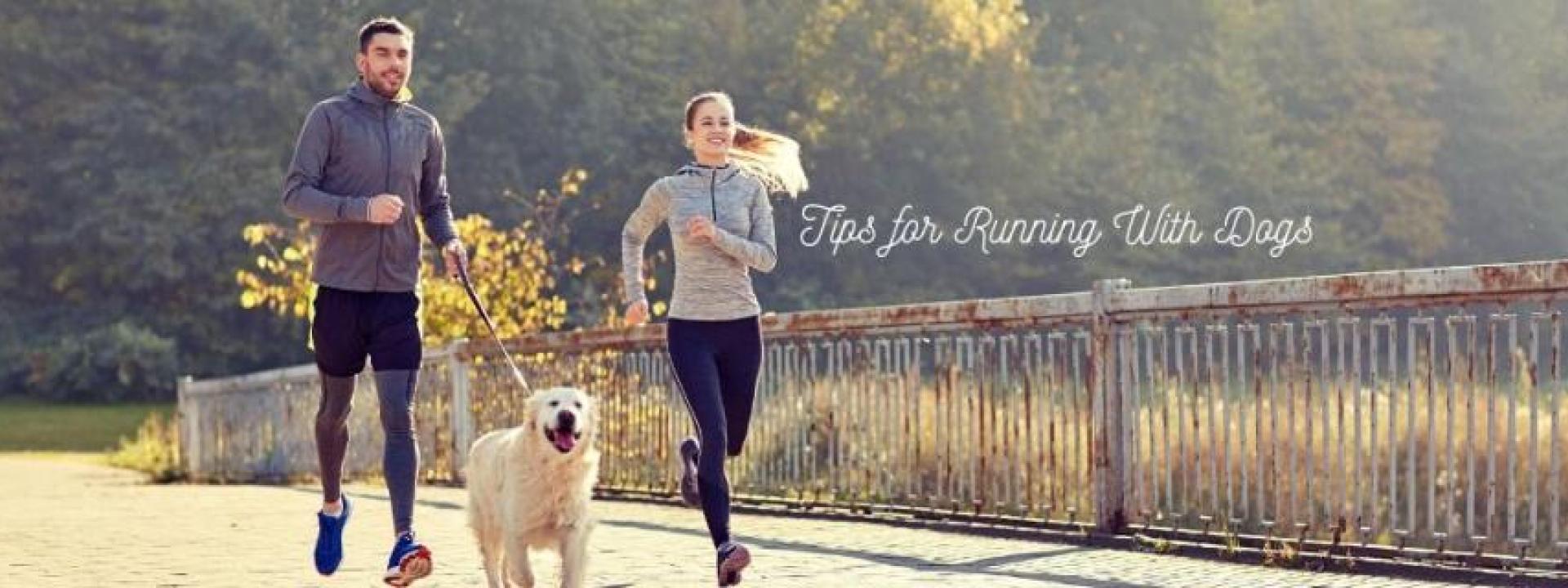We've all seen it. You're running along and the person coming at you with the gorgeous Golden Retriever has just hit her most glorious stride, and her dog stops to go to the bathroom. She's jolted backward and her face goes red, but you're not sure if it's because she's furious with her pooch or embarrassed to pick up her dog's excrement. Ahh, the joys of running with a dog. Sarcasm aside, running with your dog can be a truly wonderful experience, but a lot must go into preparing for your outing.
If you recently got a puppy or dog or have been debating about getting a dog you've had for your years out on the trail with you, it's best to do your due diligence to make sure it goes well for both you and your canine companion. And once you get the hang of it, you can even branch out by joining a dog and human running club or by signing up for canine-friendly races.
Ready to get started with exercising your dog? Read our tips on what it takes to be successful when running with your dog. ?
Know What Dog Breeds Are Best For Running
Not all dogs' bodies are created equal, and some could get seriously injured if you take them running. Runners World featured a piece on dogs that are fit for running based on the advice of JT Clough (a pro dog trainer who co-wrote a book about training dogs to run), Bryan Barrera (a professional dog runner), and Karen London (a certified animal behaviorist for the American Kennel Club). If you're looking to get a dog and one of your main goals is to have a running partner, you should likely consider one of the following breeds, or a mix of the following breeds (you might be surprised by some of them!) as recommended by the experts in the article:
- German Shorthaired Pointers
- Vizslas
- Greyhounds
- English Setters
- Golden and Labrador Retrievers
- Beagles
- Dalmatians
- Pit Bulls
- German Shepherds
- Siberian Huskies
- Pharoah Hounds
- Portuguese Water Dogs
- Australian Shepherds
- Catahoulas
- Belgian Sheepdogs
- Standard Poodles
- Malamutes
- Fox Terriers
- Rhodesian Ridgebacks
- Parson Russell Terriers
- Weimaraners
You're likely shocked to see some small breeds on this list, but many vets will tell you that they have a distinct advantage over large dogs due to having less weight on them. Some of these dogs are built for speed while others are built for endurance, so it's best to find out which yours is before you take on running with your fur friend.
Start With a Vet Check
Just as you probably want to do for yourself before taking on a vigorous exercise like running, you should get your dog checked out by a local veterinarian you trust. Even if your dog is on the list above of dogs that are typically good for running, he or she needs a clean bill of health from your veterinarian before heading out on your favorite path. Cardiovascular health needs the all-clear, as running is a high-impact, cardio-intensive exercise.
Running can also put your dog at risk for joint problems - such as luxating patellas, hip dysplasia, and arthritis - especially if your dog is already predisposed to those kinds of issues. You and your veterinarian will also need to discuss your dog's weight, as overweight dogs will obviously struggle more with running. This probably sounds counterintuitive, as running might be what you're hoping to use to slim your dog down, but you might need to help him or her lose weight through diet before taking on running.
Your vet will also likely advise against running with a brachycephalic dog such as a Pug or Bulldog, as their pushed-in noses prevent them from getting enough air to run, especially if it's a hot day.
Age is the final factor to throw in the mix, as a dog that's too old and a dog that's too young can present unique problems. An elderly dog's fitness level will not be the same as a puppy, and a dog that's too young has growth plates that are not fully closed until he is between about 1.5-2 years old (depending on breed). If your vet advises against running with your dog, don't fret, as a long and vigorous walk can be just as enjoyable for both of you.
If your vet gives you the go-ahead to run with your dog, it's time to further prepare for the experience.
Get Your Gear
Do some research on the best running leashes and harnesses for your dog. Retractable leashes have become known for being not only menaces but also as downright dangerous—on runs and walks. Try something like the Stunt Runner Hands-Free Dog Leash from amazon.com. Consider bringing along some treats for your furry friend and a collapsable water bowl, even if the weather isn't that hot. Keep in mind, though, that having your dog drink too much water can be bad for him or her, so check with your vet on how much is a safe amount. As always, don't forget your bags, as fellow runners will always appreciate you cleaning up after your dog.
Ensure That Your Path is Dog-Friendly
Choosing a path that's good for your dog isn't much different than choosing one that's good for you. You probably want to avoid sidewalks and streets due to the pavement being tough on joints. And if you have to go on the pavement, you want to touch it with your hand first. If it's too hot for your palm, it's too hot for your pooch. However, if you choose a dirt path, you want to avoid ones that have uneven surfaces or other hazards, as that can negatively affect your hips and other body parts.
The average dog can run between 2-5 miles, so start out with a slow pace and a shorter course and gradually work your way up to avoid injuring your dog.
Make Sure Your Dog is Socialized
Dog running programs are becoming increasingly popular across the country and can be a great way to meet new people while getting fit. First and foremost, you want to make sure your dog is up for this kind of social interaction. Socializing your dog is important for everyday life but particularly important for running with him or her. This is even truer if you plan on joining a running club with other humans and dogs.
Your veterinarian can recommend positive reinforcement classes by way of behavior training, which is crucial to take before running with a group if your dog has been shown to lack manners or display aggression. The last thing you want to have happen is for your dog to panic and hurt someone or another dog.
Watch Your Dog For Important Cues
Cats often get a reputation for keeping to themselves and not really letting on when they are in pain. On the other hand, dogs' body language is typically easy to read. If your dog begins to slow down, don't push it. If he or she is panting or having difficulty breathing, you've likely overdone it. Stop for a few minutes and if your dog doesn't recover, call your vet - especially if your dog's tongue has changed from a pink hue to blue.
When it comes down to it, heat is really the most important factor to take into consideration when deciding whether to run with your dog on a particular day. Not only are dogs naturally wearing fur coats, but they sweat through their paws and panting as opposed to their skin. If you think it might be too hot, it probably is. Don't risk it. You can try again on a cooler day or evening.
...
If you're thinking of getting your dog on a regular running program, contact us today to make sure your beloved pet is physically up to the task.

